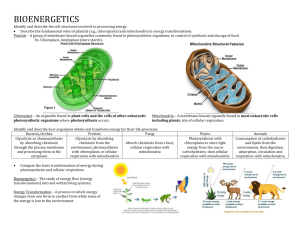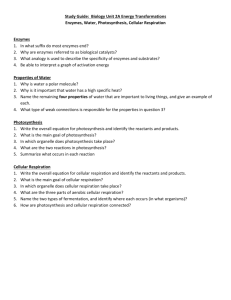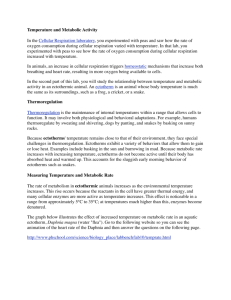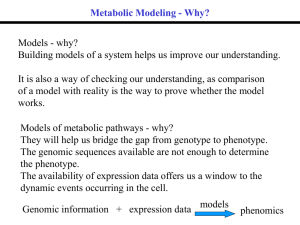Gr12 Bio Course Expectations - CIA-Biology-2011-2012
advertisement
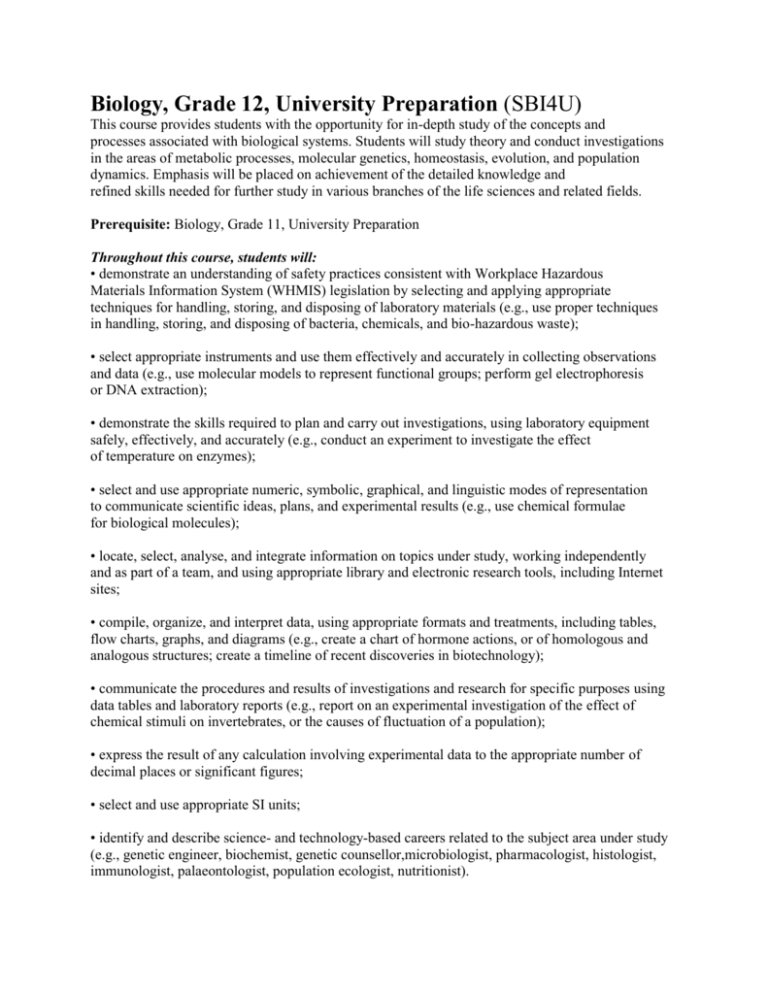
Biology, Grade 12, University Preparation (SBI4U) This course provides students with the opportunity for in-depth study of the concepts and processes associated with biological systems. Students will study theory and conduct investigations in the areas of metabolic processes, molecular genetics, homeostasis, evolution, and population dynamics. Emphasis will be placed on achievement of the detailed knowledge and refined skills needed for further study in various branches of the life sciences and related fields. Prerequisite: Biology, Grade 11, University Preparation Throughout this course, students will: • demonstrate an understanding of safety practices consistent with Workplace Hazardous Materials Information System (WHMIS) legislation by selecting and applying appropriate techniques for handling, storing, and disposing of laboratory materials (e.g., use proper techniques in handling, storing, and disposing of bacteria, chemicals, and bio-hazardous waste); • select appropriate instruments and use them effectively and accurately in collecting observations and data (e.g., use molecular models to represent functional groups; perform gel electrophoresis or DNA extraction); • demonstrate the skills required to plan and carry out investigations, using laboratory equipment safely, effectively, and accurately (e.g., conduct an experiment to investigate the effect of temperature on enzymes); • select and use appropriate numeric, symbolic, graphical, and linguistic modes of representation to communicate scientific ideas, plans, and experimental results (e.g., use chemical formulae for biological molecules); • locate, select, analyse, and integrate information on topics under study, working independently and as part of a team, and using appropriate library and electronic research tools, including Internet sites; • compile, organize, and interpret data, using appropriate formats and treatments, including tables, flow charts, graphs, and diagrams (e.g., create a chart of hormone actions, or of homologous and analogous structures; create a timeline of recent discoveries in biotechnology); • communicate the procedures and results of investigations and research for specific purposes using data tables and laboratory reports (e.g., report on an experimental investigation of the effect of chemical stimuli on invertebrates, or the causes of fluctuation of a population); • express the result of any calculation involving experimental data to the appropriate number of decimal places or significant figures; • select and use appropriate SI units; • identify and describe science- and technology-based careers related to the subject area under study (e.g., genetic engineer, biochemist, genetic counsellor,microbiologist, pharmacologist, histologist, immunologist, palaeontologist, population ecologist, nutritionist). Metabolic Processes Overall Expectations By the end of this course, students will: • describe the structure and function of the macromolecules necessary for the normal metabolic functions of all living things, and the role of enzymes in maintaining normal metabolic functions; • conduct laboratory investigations into the transformation of energy in the cell, including photosynthesis and cellular respiration, and into the chemical and physical properties of biological molecules; • explain ways in which knowledge of the metabolic processes of living systems can contribute to technological development and affect community processes and personal choices in everyday life. Specific Expectations Understanding Basic Concepts By the end of this course, students will: – apply the laws of thermodynamics to the transfer of energy in the cell, particularly with respect to respiration and photosynthesis; – identify the functional groups within biological molecules (e.g., hydroxyl, carbonyl, carboxyl, amino, phosphate) and explain how they contribute to the function of each molecule (e.g., use molecular models to determine whether a molecule is polar or non-polar, and relate this property to diffusion through a plasma membrane); – describe the chemical structure, mechanisms, and dynamics of enzymes in cellular metabolism (e.g., the function of enzymes in metabolic reactions in mitochondria or chloroplasts); – identify and describe the four main types of biochemical reactions: redox, hydrolysis, condensation, and neutralization; – describe how such molecules as glucose, ATP, pyruvic acid, NADH, and oxygen function within energy transformations in the cell, and explain the roles of such cell components as mitochondria, chloroplasts, and enzymes in the processes of cellular respiration and photosynthesis; – compare matter and energy transformations associated with the processes of cellular respiration (aerobic and anaerobic) and photosynthesis (e.g., for each process, compare the role of oxygen and the role of organelles, such as mitochondria and chloroplasts). Developing Skills of Inquiry and Communication By the end of this course, students will: – formulate operational definitions of the terms related to metabolic processes (e.g., use the following terms in relation to cell metabolism: electronegativity, isomer, functional group, polymer, organic acid, organic base, solubility, enzyme, substrate, reaction rate); – investigate the structures of biological molecules and functional groups using computer-generated, three-dimensional images and/or by building molecular models (e.g., simple carbohydrates, amino acids, simple polypeptides); – investigate and explain the relationship between metabolism and the structure of biomolecules, using problem-solving techniques (e.g., analyse the difference between the metabolic rates of sweet corn and starchy corn); – design and carry out an experiment related to a cell process (e.g., enzyme activity, membrane transport), controlling the major variables and adapting or extending procedures where required (e.g., conduct an experiment to find optimal conditions [pH, concentration, and temperature] for various enzymes and membrane transport); – determine the similarities and differences between mitochondria and chloroplasts (e.g., compare the structure and function of a mitochondrion and a chloroplast by examining micrographs and identifying reactants, products, and pathways); – interpret qualitative and quantitative observations, gathered through investigation, of the products of cellular respiration and photosynthesis (e.g., type and quantity produced) and, either by hand or by computer, compile and display the results in an appropriate format. Relating Science to Technology, Society, and the Environment By the end of this course, students will: – relate knowledge gained from their current studies of metabolism to their learning in the fields of chemical thermodynamics and physical energy; – describe technological applications of enzyme activity in the food and pharmaceutical industries (e.g., the production of dairy products using micro-organisms; the use of yeast to make bread; the use of enzymes to control reaction rates in the pharmaceutical industry); – explain the relevance, in their personal lives and the life of the community, of the study of cell biology and related technologies (e.g., explain how their learning about metabolic processes is relevant to their personal choices about exercise, diet, and the use of pharmacological substances).


